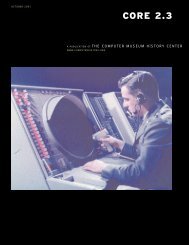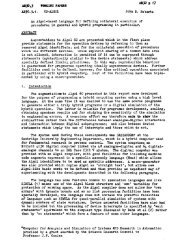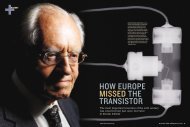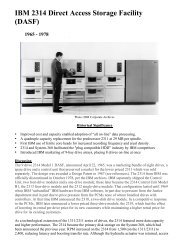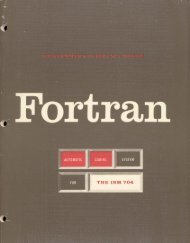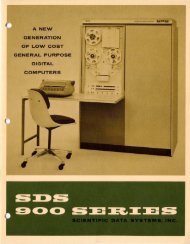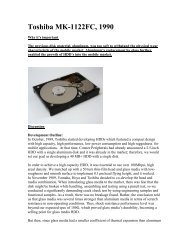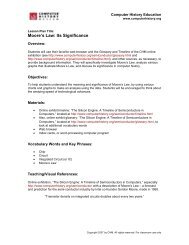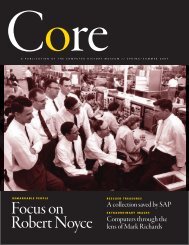Perceptions of Technology: Its Hidden Art and Beauty - Computer ...
Perceptions of Technology: Its Hidden Art and Beauty - Computer ...
Perceptions of Technology: Its Hidden Art and Beauty - Computer ...
- No tags were found...
You also want an ePaper? Increase the reach of your titles
YUMPU automatically turns print PDFs into web optimized ePapers that Google loves.
<strong>Computer</strong> History Educationwww.computerhistory.orgLesson Plan Title:<strong>Perceptions</strong> <strong>of</strong> <strong>Technology</strong>: <strong>Its</strong> <strong>Hidden</strong> <strong>Art</strong> <strong>and</strong> <strong>Beauty</strong>Overview:Students will be led to underst<strong>and</strong> that there is a relationship between technology <strong>and</strong> art. They will beshown that technology artifacts <strong>and</strong> computer components may also be viewed as artistic creations bytheir inventors. Students will be asked to react with a new artistic appreciation to underst<strong>and</strong> the ‘hiddenbeauty’ behind technological objects, <strong>and</strong> then (optionally) work individually with a variety <strong>of</strong> materials tocreate their own abstract piece <strong>of</strong> technological art.Objective:To underst<strong>and</strong> that technological objects can be visually perceived as artistic objects. Students will view atechnological object from the online exhibit as an object <strong>of</strong> art. They will share their perceptions <strong>of</strong> thepiece, with an underst<strong>and</strong>ing that colors, forms, shapes, <strong>and</strong> other visual elements are additionalcharacteristics that should be appreciated <strong>and</strong> perceived. Students will learn that the artists <strong>and</strong>inventors <strong>of</strong> the past (<strong>and</strong> future) were able to see things differently. Optional activity: they will then makean abstract art object <strong>of</strong> their own.Optional Materials:R<strong>and</strong>omly-located objects to build with, including but not limited to: aluminum foil, wire, paper clips,pipe cleaners, cardboard, paper, metal pieces, tape <strong>and</strong> glue.Teaching Strategy/Procedure:1. View (through projection or online) the 1947 timeline image <strong>of</strong> “Bardeen <strong>and</strong> Brattain’s first pointcontacttransistor” (pictured below), located in the online exhibit timeline, “The Silicon Engine: ATimeline <strong>of</strong> Semiconductors in <strong>Computer</strong>s,“ located athttp://www.computerhistory.org/semiconductor/timeline.htmlSimplified DiagramCopyright 2007 by CHM. All rights reserved. For classroom use only
<strong>Computer</strong> History Educationwww.computerhistory.org2. Ask for reactions to the object, including these suggested questions, or questions <strong>of</strong> your own.The last few questions may require further research <strong>and</strong> study:• What does it look like?• What components is it possibly made from?• Is it accidentally or deliberately ‘artistic’? Explain your reasoning.• What is your reaction to the idea that this crude device was one <strong>of</strong> the most importantdiscoveries or inventions in modern history?• How is this object identified or described on the timeline? What is its function? How do youthink it ‘works’?3. Optional activity: Students will use the materials available to them to make an abstract piece <strong>of</strong>art. When completed, have volunteers share their work with the class.Reference: Facts about the Device <strong>and</strong> <strong>Its</strong> Functionality• The ‘first’ transistor was about a ½ inch high.• A plastic triangular wedge was lightly suspended or held by a paper-clip spring above agermanium crystal (that served as a good semi-conductor).• The germanium itself was sitting on a metal base or plate attached to a voltage source.• A single strip or ribbon <strong>of</strong> gold foil was wrapped or attached around the point <strong>of</strong> the plastictriangle. The gold foil was sliced with a razor blade so that the two gold contacts were separatedby only a tiny gap <strong>of</strong> a few thous<strong>and</strong>ths <strong>of</strong> an inch (or millimeter).• The contacts at the point <strong>of</strong> the triangle were gently lowered to lightly touch the surface <strong>of</strong> thegermanium crystal.• The transistor action (or amplification effect) took place when the two pointed metal contacts werepressed onto the surface <strong>of</strong> the semiconductor material.• When a small bit <strong>of</strong> electric current came through one <strong>of</strong> the gold contacts, another evenstronger, proportionately-amplified current came out the other side <strong>of</strong> the contact.http://clinton4.nara.gov/media/jpg/replica-<strong>of</strong>-first-transistor.jpgCopyright 2007 by CHM. All rights reserved. For classroom use only



